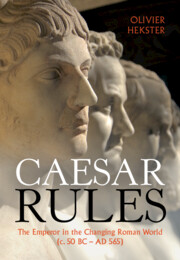Book contents
- Caesar Rules
- Caesar Rules
- Copyright page
- Dedication
- Epigraph
- Contents
- Figures
- Maps
- Graphs
- Preface
- Timeline
- Abbreviations
- Introduction
- 1 Portraying the Roman Emperor
- 2 Playing Imperial Roles
- 3 Being around the Emperor
- 4 The Emperor in the Capital and Provinces
- Conclusions
- Appendix
- Glossary
- Bibliography
- Index of Persons and Places
- General Index
1 - Portraying the Roman Emperor
Published online by Cambridge University Press: 23 November 2022
- Caesar Rules
- Caesar Rules
- Copyright page
- Dedication
- Epigraph
- Contents
- Figures
- Maps
- Graphs
- Preface
- Timeline
- Abbreviations
- Introduction
- 1 Portraying the Roman Emperor
- 2 Playing Imperial Roles
- 3 Being around the Emperor
- 4 The Emperor in the Capital and Provinces
- Conclusions
- Appendix
- Glossary
- Bibliography
- Index of Persons and Places
- General Index
Summary
In many ways, the development of the image of Roman emperors was a search for a way to make the supreme position of the emperor recognisable in an acceptable way, through tools that were already available. Emperorship was never unambiguously defined, other than by the name Augustus. Over time, the range of options which emperors and the inhabitants of the empire had to portray the ruler extended as previously less acceptable modes of representation became normalised. At the same time, there was some sort of congruence in what were typical imperial attributes. The much-discussed ceremonial reforms of Diocletian were a confirmation of practice, rather than a watershed. They did not end the variety of imagery. Expectations of how emperors ought to be described and portrayed continued to differ regionally, medially and between social groups, even when typically imperial modes of representation, with diadem, purple cloak and standardised facial features solidified. Very few typically imperial features, the diadem excepted, were unique to the emperor. For many people, the Roman emperor would always remain a distant figure, far removed from their daily life
- Type
- Chapter
- Information
- Caesar RulesThe Emperor in the Changing Roman World (c. 50 BC – AD 565), pp. 23 - 105Publisher: Cambridge University PressPrint publication year: 2022

